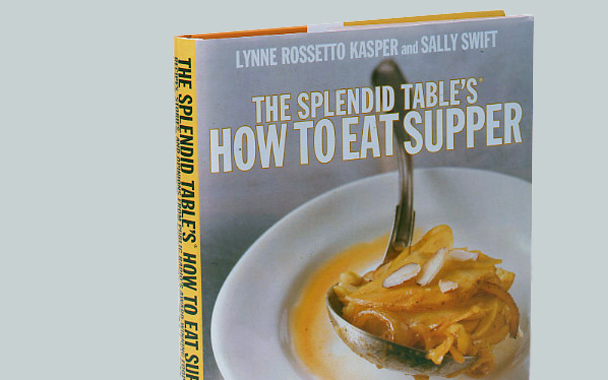I never realized I was in a cooking rut because getting dinner on the table was always a pleasure. My culinary repertoire was hopelessly segregated, though: Dried chiles remained tucked in the pantry unless I was preparing something full-on Mexican; miso paste resided in the fridge until I dabbled in Japanese; and I firmly directed pancetta into my Italian dishes and bacon into my American ones. I thought this was perfectly logical; otherwise, how could I be certain that the flavors on the table would harmonize?
Then along came The Splendid Table’s How to Eat Supper, a book that shook me awake—and will do the same for you, too, even if you happen to be in a rut of not cooking. Back in 2002, Lynne Rossetto Kasper, cookbook author and host of the nationally syndicated public radio show, The Splendid Table, along with her producer Sally Swift, hatched a plan to send weekly recipes (that could really be cooked within the tight time constraints of weeknights) to an electronic mailing list, and the resulting landslide of subscribers proved that a major chord had been struck. It’s specifically the weeknight supper that Kasper and Swift are hoping to inspire you to cook with this manifesto—and indeed, you’d be hard-pressed to find a recipe in it that requires a visit to a specialty market or that takes more than 30 minutes to prepare.
The speed and simplicity of the recipes will appeal to newbie cooks, but kitchen pros will get a lot out of this book as well. Though the recipes are culled from the whole globe’s worth of influences, few are demonstrably ethnic; ingredients and seasonings are used subtly, to enhance flavor, rather than to bestow some sort of cultural authenticity. The miso in Mushroom Ambrosia, for example, doesn’t cast an Asian shadow over the dish, nor does it, as Kasper and Swift posit, make it “taste like chicken.” That would be selling it too short. What it does do is infuse the mushrooms with an incredible, silken, umami depth; consequently, the dish would fit comfortably in the context of virtually any meal.
Sprinkled throughout the book are the charming tidbits that Splendid Table listeners expect: anecdotes, tips, and trivia, along with suggestions of classic titles—some new, some obscure—for those interested in building a cookbook library. But perhaps the book’s most refreshing aspect is its authoritative demystification of cooking. Take Dumbed Down Rice, for instance. When was the last time a knowledgeable cook admitted that it’s just fine to cook rice “like pasta,” boiling it in lots of water and simply dumping the excess liquid? Surprise—the method really does turn out great rice. And my jaw dropped after tasting Cheater’s Homemade Broth. To be fair, Kasper and Swift aren’t trying to replace homemade chicken stock for those who regularly make it; but their quickie doctored broth has much more oomph than the thin, flat canned stuff. (Once strained, Cheater’s Broth has a body and roundness to it that you’d swear came from a pot of simmered bones—and worked into other recipes, it’s even more difficult to discern that it didn’t.)
The underlying spirit here—one that encourages playing around with your food—makes for seriously enjoyable reading and lots of cooking inspiration. Whether it has been lack of time or intimidation that has kept you in a rut, just shake it off, and go fix yourself something to eat.


